Spatial Distribution of Uranium and Thorium in the Soils of North Macedonia
Abstract
1. Introduction
2. Materials and Methods
2.1. Study Area
2.2. Geological Characteristics
2.3. Pedological Characteristics
2.4. Soil Sampling and Analysis
3. Results and Discussion
4. Conclusions
Author Contributions
Funding
Data Availability Statement
Acknowledgments
Conflicts of Interest
References
- Hazen, R.M.; Ewing, R.C.; Sverjensky, D.A. Evolution of Uranium and Thorium Minerals. Am. Min. 2009, 94, 1293–1311. [Google Scholar] [CrossRef]
- Sources and Effects of Ionizing Radiation; United Nations Scientific Committee on the Effects of Atomic Radiation, Report to the General Assembly, with Scientific Annexes; United Nations: New York, NY, USA, 2000.
- Sartandel, S.J.; Jha, S.K.; Bara, S.V.; Tripathi, R.M.; Puranik, V.D. Spatial Distribution of Uranium and Thorium in the Surface Soil Around Proposed Uranium Mining Site at Lambapur and its Vertical Profile in the Nagarjuna Sagar Dam. J. Environ. Radioact. 2009, 100, 831–834. [Google Scholar] [CrossRef] [PubMed]
- Cowart, J.B.; Burnett, W.C. The Distribution of Uranium and Thorium Decay-series Radionuclides in the Environment—A Review. J. Environ. Qual. 1994, 23, 651–662. [Google Scholar] [CrossRef]
- Rudnick, R.L.; Gao, S. Composition of the Continental Crust. Treat. Geochem. 2014, 4, 1–64. [Google Scholar]
- Salminen, R.; Batista, M.J.; Bidovec, M.; Demetriades, A.; De Vivo, B.; De Vos, W.; Duris, M.; Gilucis, A.; Gregorauskiene, V.; Halamic, J.; et al. Geochemical atlas of Europe, Part 1, Background Information, Methodology and Maps; Geological Survey of Finland: Espoo, Finland, 2005. [Google Scholar]
- Reimann, C.; Birke, M.; Demetriades, A.; Filzmoser, P.; O’Connor, P. Chemistry of Europe’s Agricultural Soils—Part A: Methodology and Interpretation of the GEMAS Data Set; Geologisches Jahrbuch Reihe B, Band B 103; Schweizerbart Science Publishers: Stuttgart, Germany, 2014. [Google Scholar]
- Hu, Z.; Gao, S. Upper Crustal Abundances of Trace Elements: A Revision and Update. Chem. Geol. 2008, 253, 205–221. [Google Scholar] [CrossRef]
- Lauf, R. Mineralogy of Uranium and Thorium, 1st ed.; Schiffer Publishing Ltd.: Littleton, CO, USA, 2016. [Google Scholar]
- Pagano, G.; Aliberti, F.; Guida, M.; Oral, R.; Siciliano, A.; Trifuoggi, M.; Tommasi, F. Rare Earth Elements in Human and Animal Health: State of Art and Research Priorities. Environ. Res. 2015, 142, 215–220. [Google Scholar] [CrossRef]
- Coyte, R.M.; Jain, R.C.; Srivastava, S.K.; Sharma, K.C.; Khalil, A.; Ma, L.; Vengosh, A. Large–scale Uranium Contamination of Groundwater Resources in India. Environ. Sci. Technol. Lett. 2018, 5, 341–347. [Google Scholar] [CrossRef]
- Gu, H.; Wang, N.; Yang, Y.; Zao, C.; Cui, S. Features of Distribution of Uranium and Thorium in Red Mud. Physicochem. Probl. Miner. Process. 2017, 53, 110–121. [Google Scholar]
- Gwenzi, W.; Mangori, L.; Danha, C.; Chaukura, N.; Dunjana, N.; Sanganyado, E. Sources, Behaviour, and Environmental and Human Health Risks of High-technology Rare Earth Elements as Emerging Contaminants. Sci. Total Environ. 2018, 636, 299–313. [Google Scholar] [CrossRef]
- Kasar, S.; Sahoo, S.K.; Area, H.; Mishra, S.; Tokonami, S.; Aono, T. Uranium, Thorium, and Rare Earth Elements Distribution in Fukushima Soil Samples. Radiat. Protect. Dosim. 2019, 184, 363–367. [Google Scholar] [CrossRef]
- Jimenez-Ballesta, R.; Bravo, S.; Perez-de los Reyes, C.; García-Pradas, J.; Sanchez, M.; García-Navarro, F.J. Occurrence of Some Rare Earth Elements in Vineyard Soils under Semiarid Mediterranean Environment. Environ. Monit. Assess. 2021, 194, 341. [Google Scholar]
- Pereto, C.; Baudrimont, M.; Coynel, A. Global Natural Concentrations of Rare Earth Elements in Aquatic Organisms: Progress and Lessons from Fifty Years of Studies. Sci. Total Environ. 2024, 922, 171241. [Google Scholar] [CrossRef]
- Sánchez-Castro, I.; Martínez-Rodríguez, P.; Abad, M.M.; Descostes, M.; Merroun, M.L. Uranium removal from complex mining waters by alginate beads doped with cells of Stenotrophomonas sp. Br8: Novel perspectives for metal bioremediation. J. Environ. Manage 2021, 296, 113411. [Google Scholar] [CrossRef] [PubMed]
- Stojanovska, Z.; Boev, B.; Ristova, M. Spatial Distribution of K, Th and U Elemental Concentration in Soil of the Republic of Macedonia. In Proceedings of the 1st International Workshop of the UNESCO-IGCP Project “Anthropogenic Effects on the Human Environment in the Neogene Basins in the SE Europe, Štip, North Macedonia, 3–4 June 2011; Serafimovski, T., Boev, B., Eds.; Faculty of Natural and Technical Sciences: Štip, North Macedonia, 2011; pp. 53–62. [Google Scholar]
- Stojanovska, Z.; Boev, B.; Ristova, M.; Boev, I.B.; Sorsa, A.; Zunic, Z.S.; Georgieva Ivanova, K. Risk Assessment Resulting from Radionuclides in Soils of the Republic of Macedonia. Contrib. Sect. Nat. Math. Biotech. Sci. MASA 2019, 40, 161–168. [Google Scholar]
- Stojanovska, Z.; Boev, B.; Bossew, P.; Ristova, M.; Dimov, G.; Zunic, Z.S. Analysis of Radionuclides Specific Activities Variations in Soil within Geotectonic Units of Republic of Macedonia. Nucl. Technol. Radiat. Protect. 2019, 34, 85–93. [Google Scholar] [CrossRef]
- Dimovska, S.; Stafilov, T.; Šajn, R.; Frontasyeva, M. Distribution of Some Natural and Man-made Radionuclides in Soil from the City of Veles (Republic of Macedonia) and its Environs. Radiat. Prot. Dosim. 2010, 138, 144–157. [Google Scholar] [CrossRef]
- Dimovska, S.; Stafilov, T.; Šajn, R. Radioactivity in Soil from the City of Kavadarci (Republic of Macedonia) and its Environs. Radiat. Prot. Dosim. 2012, 148, 107–120. [Google Scholar] [CrossRef]
- Zlatanovska, I.; Stafilov, T.; Šajn, R.; Dimovska Gonovska, B.; Dimovska, S.; Janushevski, J.; Barandovski, L. Distribution of Some Natural and Artificial Radionuclides in Soil from the City of Bitola (Macedonia) and its Environs. Radiat. Protect. Dosim. 2024, 200, 901–918. [Google Scholar] [CrossRef]
- Zlatanovska, I.; Stafilov, T.; Šajn, R.; Dimovska Gonovska, B.; Dimovska, S.; Janushevski, J.; Barandovski, L. Assessment of Radiological Hazards of Soils from the City of Bitola (Macedonia) and its Environs. Isot. Environ. Health Stud. 2024, 60, 453–470. [Google Scholar] [CrossRef]
- Stafilov, T.; Šajn, R. Geochemical Atlas of the Republic of Macedonia; Faculty of Natural Sciences and Mathematics: Skopje, North Macedonia, 2016. [Google Scholar]
- Petrušev, E.; Stolić, N.; Šajn, R.; Stafilov, T. Geological Characteristics of the Republic of North Macedonia. Geol. Maced. 2021, 35, 49–55. [Google Scholar] [CrossRef]
- Pendžerkovski, J. Interpreter of the Geological Map of 1:200,000 of SR Macedonia; Professional Fund of the Geological Survey of Macedonia: Skopje, North Macedonia, 1976. [Google Scholar]
- Pendžerkovski, J.; Hadži-Mitrova, S. Interpreter of the Geological Map of SR Macedonia 1:200,000; Professional Fund of the Geological Survey of Macedonia: Skopje, North Macedonia, 1977. [Google Scholar]
- Dumurdžanov, N.; Serafimovski, T.; Burchfiel, B.C. Evolution of the Neogene-Pleistocene Basins of Macedonia. Digital Map and Chart Series 1 (Accompanying Notes); Geological Society of America: Boulder, CO, USA, 2004. [Google Scholar]
- Dumurdžanov, N.; Serafimovski, T.; Burchfiel, B.C. Cenozoic Tectonics of Macedonia and its Relation to the South Balkan Extensional Regime. Geosphere 2005, 1, 1–22. [Google Scholar] [CrossRef]
- Arsovski, M. Tectonics of Macedonia; Faculty of Mining and Geology, Ss Cyril and Methodius University: Skopje, North Macedonia, 1997. [Google Scholar]
- Filipovski, G.; Andreevski, M.; Vasilevski, K.; Milevski, I.; Markoski, M.; Mitkova, T.; Mitrikeski, J.; Mukaetov, D.; Petkovski, D. Pedological (Soil) Map; Institute of Agriculture, Ss Cyril and Methodius University: Skopje, North Macedonia, 2015. [Google Scholar]
- Mitkova, T.; Mitrikeski, J. Soils of the Macedonia: Present Situation and Future Prospects. In Soil Resources of Europe, 2nd ed.; Jones, R.J.A., Houšková, B., Bullock, P., Montanarella, L., Eds.; European Soil Bureau Institute for Environment & Sustainability: Ispra, Italy, 2005; pp. 225–234. [Google Scholar]
- Halamić, L.; Peh, Z.; Miko, S.; Galović, L.; Šorša, A. Geochemical Atlas of Croatia: Environmental Implications and Geodynamical Thread. J. Geochem. Explor. 2012, 115, 36–46. [Google Scholar] [CrossRef]
- Golabkesh, F.; Ghanavati, N.; Nazarpour, A.; Nejad, T.B. Monitoring Soil Salinity Changes, Comparison of Different Maps and Indices Extracted from Landsat Satellite Images (Case Study: Atabieh, Khuzestan). Pol. J. Environ. Stud. 2021, 30, 1139–1154. [Google Scholar] [CrossRef]
- Vaziri, A.; Nazarpour, A.; Ghanavati, N.; Babainejad, T.; Watts, M.J. An Integrated Approach for Spatial Distribution of Potentially Toxic Elements (Cu, Pb and Zn) in Topsoil. Sci. Rep. 2021, 11, 7806. [Google Scholar] [CrossRef] [PubMed]
- Stafilov, T.; Šajn, R.; Pančevski, Z.; Boev, B.; Frontasyeva, M.V.; Strelkova, I.P. Heavy Metal Contamination of Surface Soils around a Lead and Zinc Smelter in the Republic of Macedonia. J. Hazard. Mater. 2010, 75, 896–914. [Google Scholar] [CrossRef] [PubMed]
- Stafilov, T.; Šajn, R.; Ahmeti, L. Geochemical Characteristics of Soil of the City of Skopje, Republic of Macedonia. J. Environ. Sci. Health A 2019, 54, 972–987. [Google Scholar] [CrossRef] [PubMed]
- Reimann, C.; Filzmoser, P.; Fabian, K.; Hron, K.; Birke, M.; Demetriades, A.; Dinelli, E.; Ladenberger, A.; The GEMAS Project Team. The Concept of Compositional Data Analysis in Practice—Total Major Element Concentrations in Agricultural and Grazing Land Soils of Europe. Sci. Total. Environ. 2012, 426, 196–210. [Google Scholar] [CrossRef]
- Harvey, D. Modern Analytical Chemistry; McGraw-Hill Higher Education: New York, NY, USA, 2000. [Google Scholar]
- Borojerdnia, A.; Rozbahani, M.M.; Nazarpour, A.; Ghanavati, N.; Payandeh, K. Application of Exploratory and Spatial Data Analysis (SDA), singularity Matrix analysis, and Fractal Models to Delineate Background of Potentially Toxic Elements: A Case Study of Ahvaz, SW Iran. Sci. Total Environ. 2020, 740, 140103. [Google Scholar] [CrossRef]
- Peuraniemi, V.; Aario, R. Hydromorphic dispersion of uranium in a surficial environment in northern Finland. J. Geochem. Explor. 1991, 41, 197–212. [Google Scholar] [CrossRef]
- Åström, M.E.; Peltola, P.; Rönnback, P.; Lavergren, U.; Bergbäck, B.; Tarvainen, T.; Backman, B.; Salminen, R. Uranium in surface and groundwaters in Boreal EuropeUranium in surface and groundwaters in Boreal Europe. Geochem. Explor. Environ. Anal. 2009, 9, 51–62. [Google Scholar] [CrossRef]
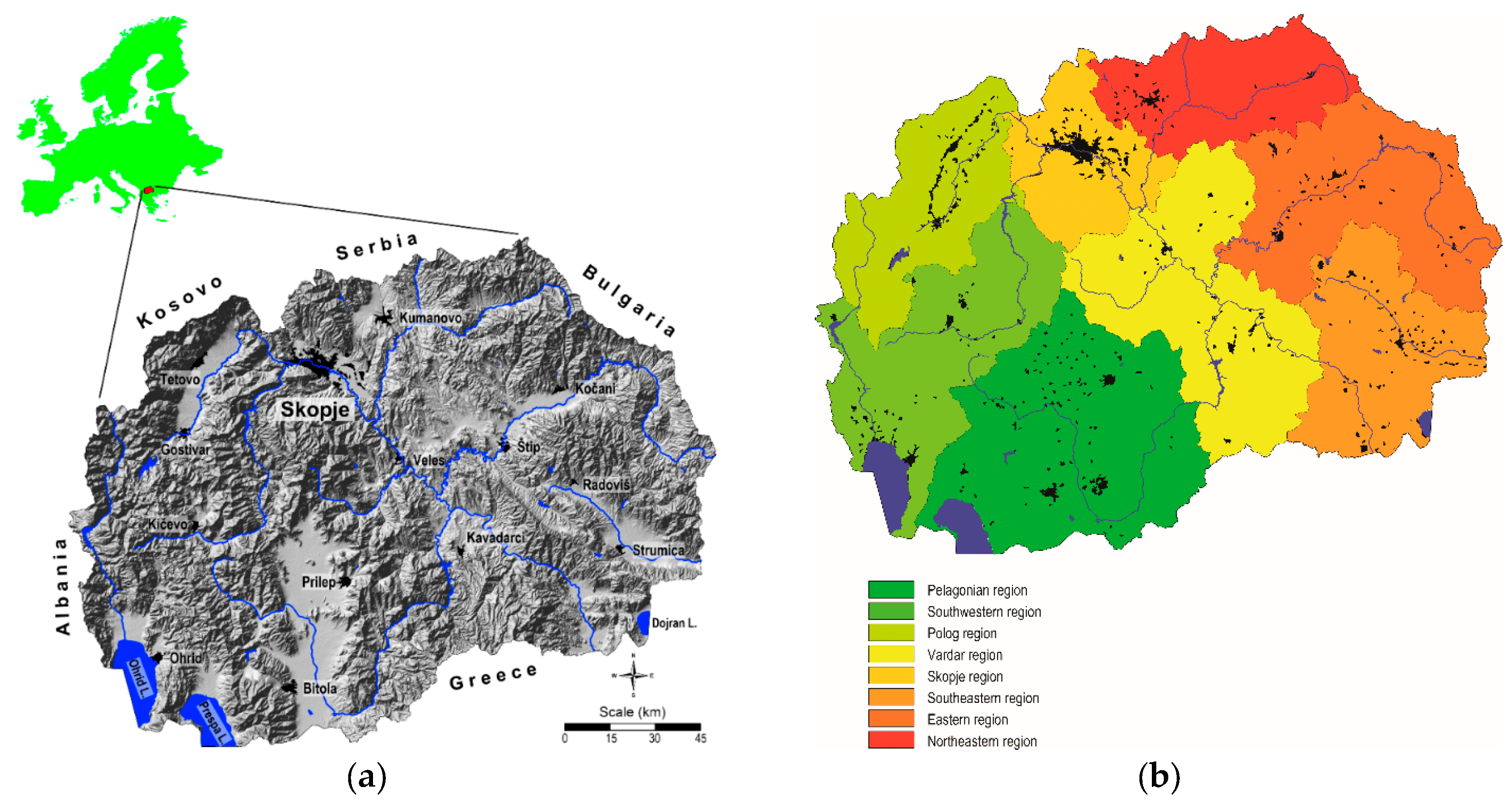
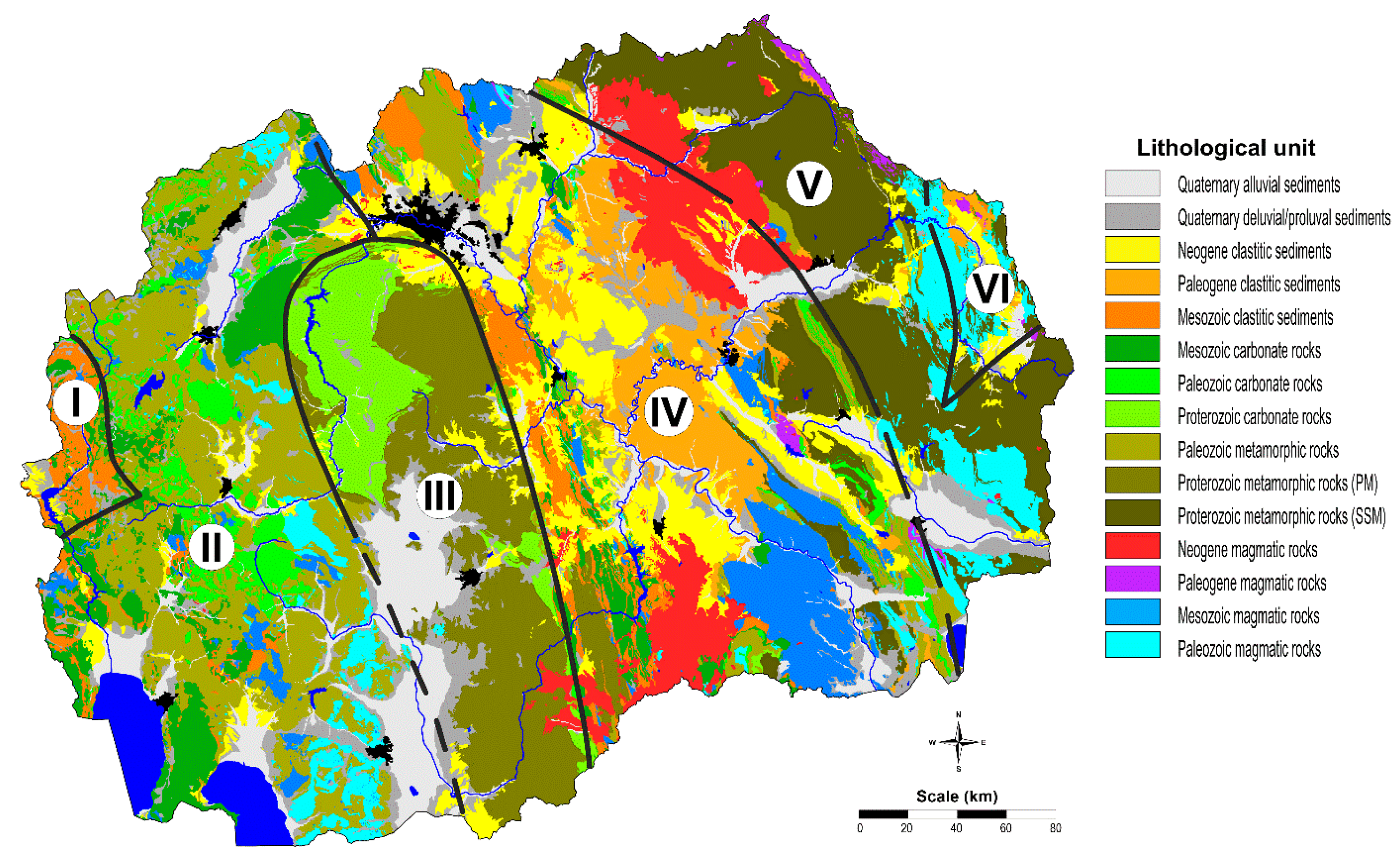

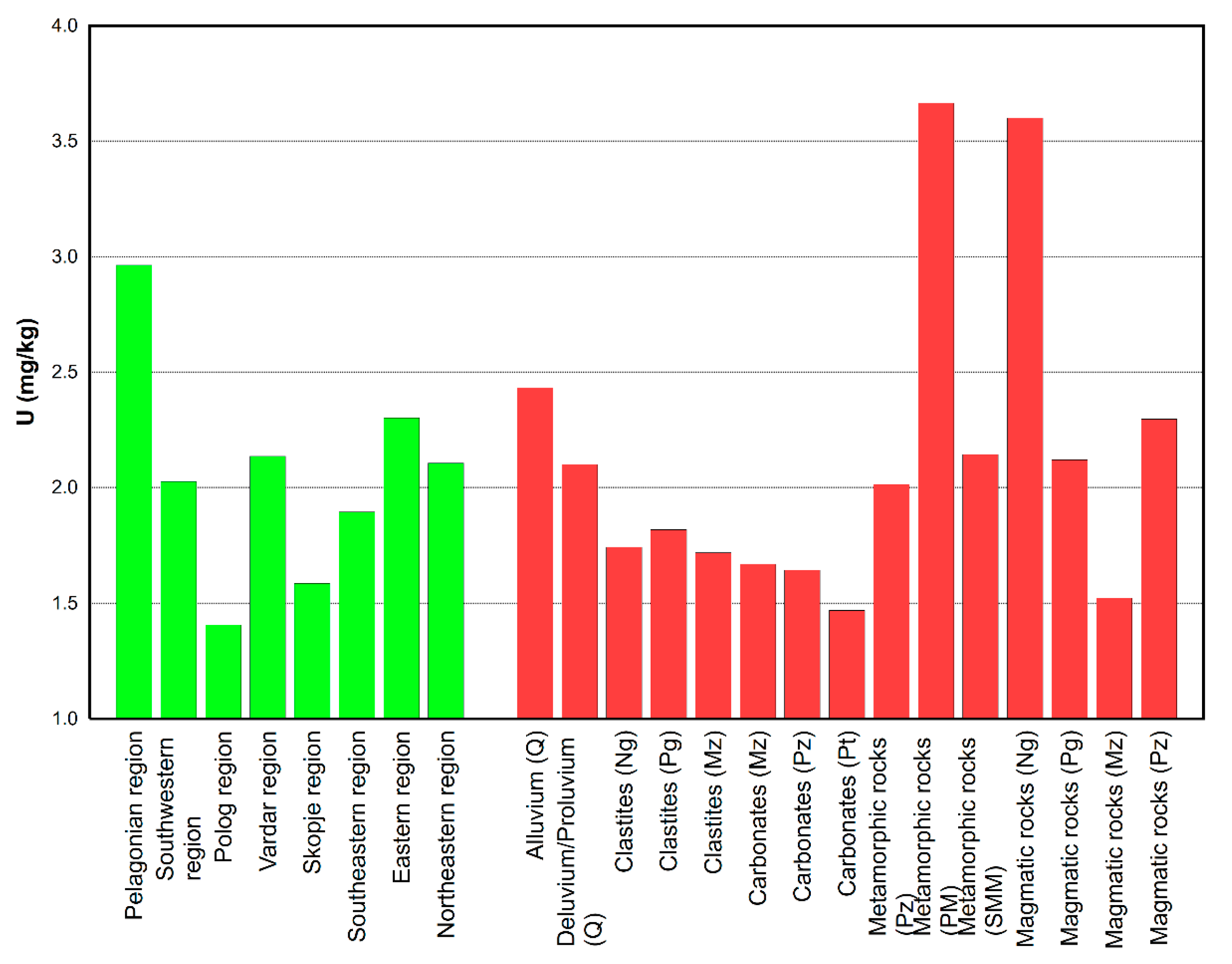
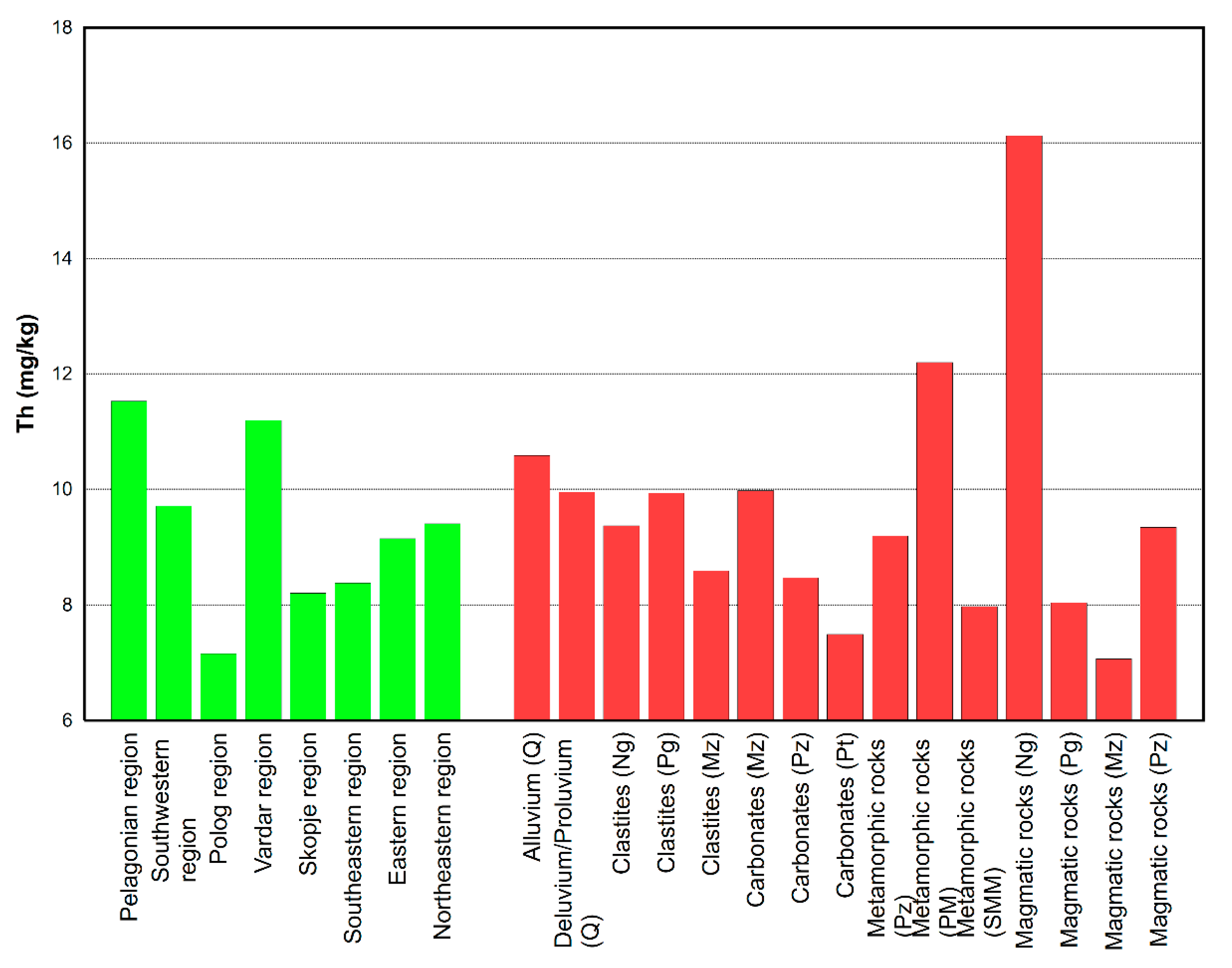
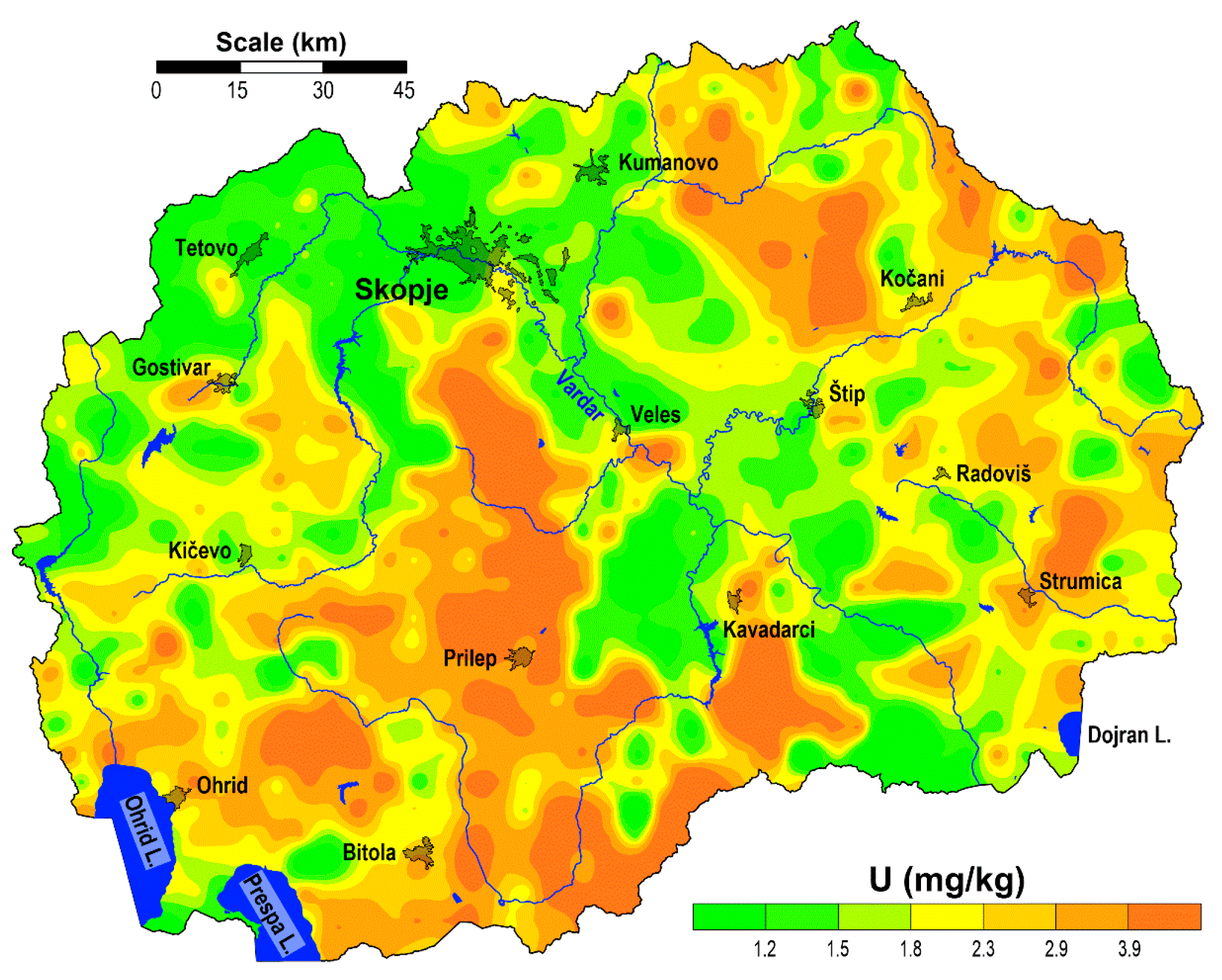
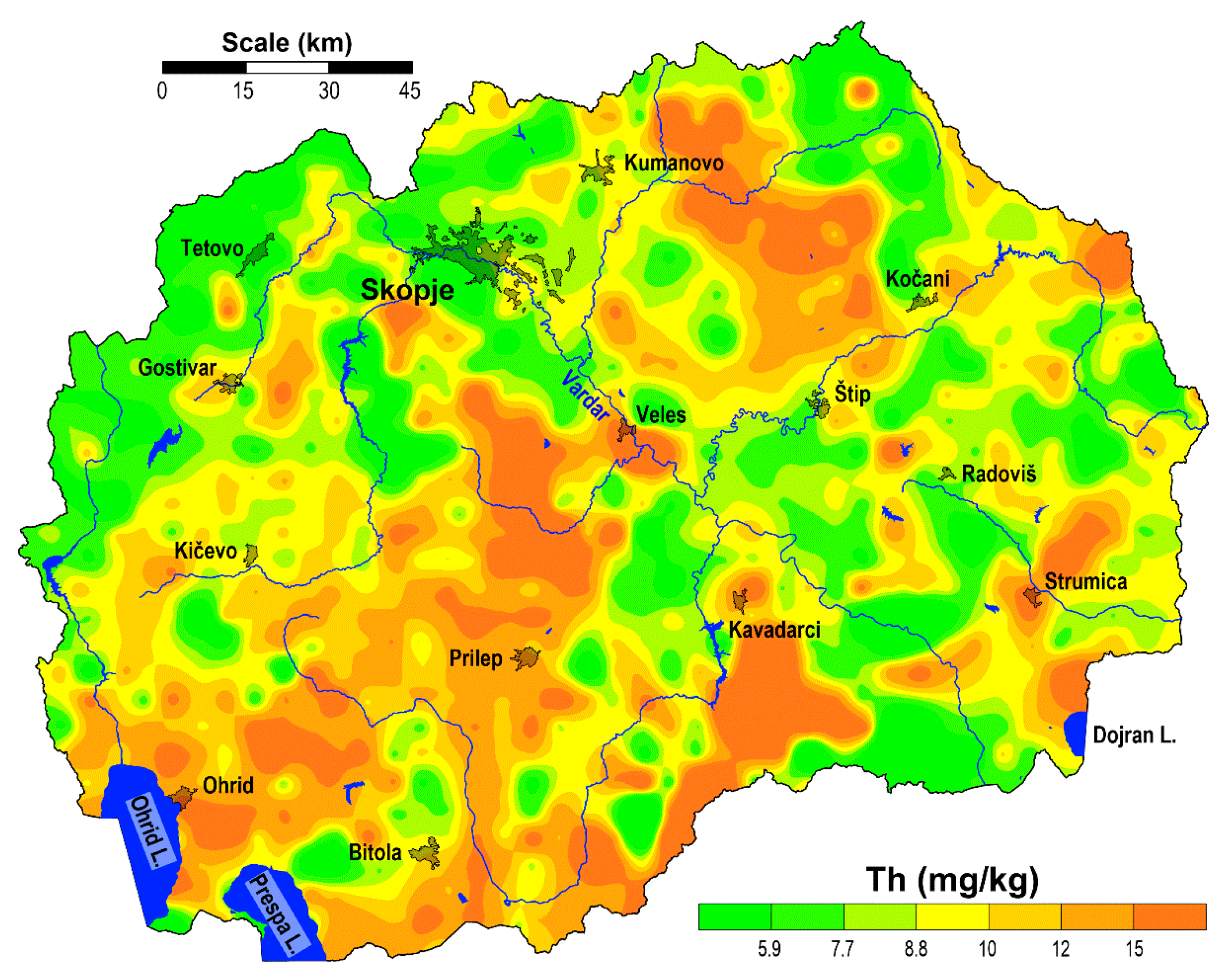
| Parameter | U (mg/kg) | Th (mg/kg) |
|---|---|---|
| Number of sampling locations | 995 | 995 |
| Detection limit | 0.10 | 0.10 |
| Arithmetic average (mean) | 2.5 | 11 |
| Geometrical mean | 2.1 | 9.3 |
| Box–Cox transformed average | 2.1 | 9.6 |
| Arithmetic standard deviation | 1.6 | 6.1 |
| Geometric standard deviation | 0.050 | 0.19 |
| Coefficient of variation | 64 | 58 |
| Minimum | <0.10 | 0.20 |
| P10—10th percentile | 1.0 | 5.2 |
| P25—25th percentile | 1.5 | 7.3 |
| Median | 2.0 | 9.5 |
| P75—75th percentile | 3.1 | 13 |
| P90—90th percentile | 4.4 | 17 |
| Maximum | 13 | 92 |
| Skewness | 2.07 | 3.95 |
| Kurtosis | 6.66 | 36.18 |
| Box–Cox transformed skewness | 0.02 | 0.11 |
| Box–Cox transformed kurtosis | 1.09 | 2.83 |
| Unit | North Macedonia, This Work | Europe, Topsoil [6] | World (Upper Continental Crust) [5] | |||
|---|---|---|---|---|---|---|
| U | Th | U | Th | U | Th | |
| Average | 2.5 | 11 | 2.36 | 8.24 | 2.7 | 10.5 |
| Median | 2.0 | 9.5 | 2.03 | 7.24 | ||
| Minimum | <0.10 | 0.20 | 0.21 | 0.30 | ||
| Maximum | 13 | 92 | 53.2 | 75.9 | ||
| Region | Number of Samples | Mean | Median | Minimum | Maximum | ||||
|---|---|---|---|---|---|---|---|---|---|
| U | Th | U | Th | U | Th | U | Th | ||
| Pelagonian | 192 | 3.0 | 12 | 3.0 | 12 | 0.3 | 0.20 | 12 | 32 |
| Southwestern | 135 | 2.0 | 9.7 | 2.1 | 10 | 0.4 | 2.2 | 8.5 | 20 |
| Polog | 96 | 1.4 | 7.2 | 1.3 | 6.9 | 0.4 | 2.0 | 4.1 | 20 |
| Vardar | 162 | 2.1 | 11 | 1.8 | 9.7 | 0.3 | 0.90 | 13 | 92 |
| Skopje | 72 | 1.6 | 8.2 | 1.5 | 8.1 | 0.6 | 2.4 | 7.5 | 28 |
| Southeastern | 105 | 1.9 | 8.4 | 2.1 | 9.1 | 0.1 | 0.70 | 9.1 | 36 |
| Eastern | 141 | 2.3 | 9.1 | 2.2 | 9.4 | 0.7 | 2.5 | 8.1 | 23 |
| Northeastern | 92 | 2.1 | 9.4 | 1.9 | 9.1 | 0.7 | 2.0 | 6.9 | 44 |
| Geology | Number of Samples | Mean | Median | Minimum | Maximum | ||||
|---|---|---|---|---|---|---|---|---|---|
| U | Th | U | Th | U | Th | U | Th | ||
| Alluvium (Q) | 114 | 2.4 | 11 | 2.4 | 10 | 0.7 | 2.3 | 7.7 | 49 |
| Deluvium (Q) | 80 | 2.1 | 10 | 2.1 | 9.9 | 0.8 | 3.5 | 6.4 | 23 |
| Clastites (Ng) | 95 | 1.7 | 9.4 | 1.7 | 8.9 | 0.6 | 2.5 | 6.3 | 52 |
| Clastites (Pg) | 60 | 1.8 | 9.9 | 1.7 | 9.1 | 0.9 | 3.8 | 8.2 | 92 |
| Clastites (Mz) | 40 | 1.7 | 8.6 | 1.4 | 8.2 | 0.6 | 2.6 | 12 | 26 |
| Carbonates (Mz) | 120 | 1.7 | 10 | 1.7 | 10 | 0.5 | 2.3 | 4.0 | 19 |
| Carbonates (Pz) | 52 | 1.6 | 8.5 | 1.6 | 8.3 | 0.8 | 2.4 | 4.4 | 30 |
| Carbonates (Pt) | 32 | 1.5 | 7.5 | 1.6 | 9.1 | 0.3 | 0.20 | 4.8 | 21 |
| Metamorphic rocks (Pz) | 43 | 2.0 | 9.2 | 2.0 | 10 | 0.4 | 1.9 | 8.5 | 21 |
| Metamorphic rocks (PM) | 84 | 3.7 | 12 | 3.7 | 12 | 0.7 | 3.0 | 13 | 42 |
| Metamorphic rocks (SMM) | 115 | 2.1 | 8.0 | 2.2 | 8.4 | 0.7 | 2.0 | 8.1 | 26 |
| Magmatic rocks (Ng) | 50 | 3.6 | 16 | 3.8 | 16 | 0.3 | 0.90 | 9.7 | 44 |
| Magmatic rocks (Pg) | 7 | 2.1 | 8.0 | 2.2 | 8.8 | 1.0 | 2.8 | 4.2 | 20 |
| Magmatic rocks (Mz) | 51 | 1.5 | 7.1 | 1.5 | 8.0 | <0.10 | 0.70 | 7.3 | 33 |
| Magmatic rocks (Pz) | 52 | 2.3 | 9.3 | 2.3 | 9.5 | 0.7 | 3.8 | 9.1 | 24 |
| Pedological Unit | Number of Samples | Mean | Median | Minimum | Maximum | ||||
|---|---|---|---|---|---|---|---|---|---|
| U | Th | U | Th | U | Th | U | Th | ||
| Lithosol | 57 | 2.0 | 10 | 2.1 | 9.8 | 0.80 | 5.6 | 4.2 | 20 |
| Lithosol (C) | 38 | 1.7 | 9.2 | 1.7 | 9.5 | 0.40 | 2.6 | 5.1 | 30 |
| Regosol | 69 | 2.3 | 11 | 2.1 | 9.9 | <0.10 | 1.1 | 9.7 | 35 |
| Colluvial soil | 55 | 2.2 | 10 | 2.2 | 9.3 | 0.60 | 3.6 | 6.7 | 49 |
| Rendzina | 72 | 1.6 | 8.9 | 1.6 | 8.2 | 0.60 | 2.6 | 6.1 | 26 |
| Ranker | 72 | 2.3 | 8.7 | 2.0 | 8.5 | 0.30 | 0.90 | 11 | 33 |
| Vertisol | 319 | 2.1 | 11 | 1.8 | 10 | 0.90 | 3.8 | 6.9 | 44 |
| Cambisol (H) | 99 | 1.8 | 8.8 | 1.8 | 9.0 | 0.60 | 2.4 | 6.4 | 19 |
| Cambisol (M) | 80 | 2.4 | 9.7 | 2.4 | 9.7 | 0.20 | 0.20 | 13 | 52 |
| Cambisol (C) | 15 | 1.5 | 7.9 | 1.5 | 8.6 | 0.40 | 2.0 | 4.8 | 22 |
| Fluvisol | 93 | 2.4 | 11 | 2.4 | 11 | 0.70 | 2.3 | 6.6 | 92 |
| Hydromorphic soil | 21 | 2.9 | 12 | 2.7 | 11 | 1.3 | 7.8 | 7.7 | 17 |
| Anthroposol | 5 | 1.1 | 6.4 | 1.1 | 6.4 | 0.80 | 3.5 | 1.8 | 9.2 |
Disclaimer/Publisher’s Note: The statements, opinions and data contained in all publications are solely those of the individual author(s) and contributor(s) and not of MDPI and/or the editor(s). MDPI and/or the editor(s) disclaim responsibility for any injury to people or property resulting from any ideas, methods, instructions or products referred to in the content. |
© 2025 by the authors. Licensee MDPI, Basel, Switzerland. This article is an open access article distributed under the terms and conditions of the Creative Commons Attribution (CC BY) license (https://creativecommons.org/licenses/by/4.0/).
Share and Cite
Stafilov, T.; Šajn, R. Spatial Distribution of Uranium and Thorium in the Soils of North Macedonia. Minerals 2025, 15, 1063. https://doi.org/10.3390/min15101063
Stafilov T, Šajn R. Spatial Distribution of Uranium and Thorium in the Soils of North Macedonia. Minerals. 2025; 15(10):1063. https://doi.org/10.3390/min15101063
Chicago/Turabian StyleStafilov, Trajče, and Robert Šajn. 2025. "Spatial Distribution of Uranium and Thorium in the Soils of North Macedonia" Minerals 15, no. 10: 1063. https://doi.org/10.3390/min15101063
APA StyleStafilov, T., & Šajn, R. (2025). Spatial Distribution of Uranium and Thorium in the Soils of North Macedonia. Minerals, 15(10), 1063. https://doi.org/10.3390/min15101063









